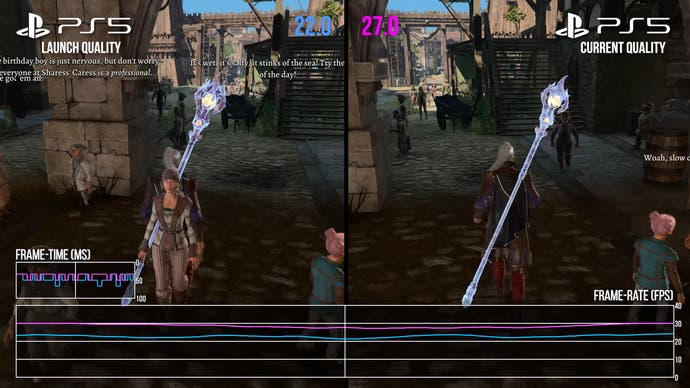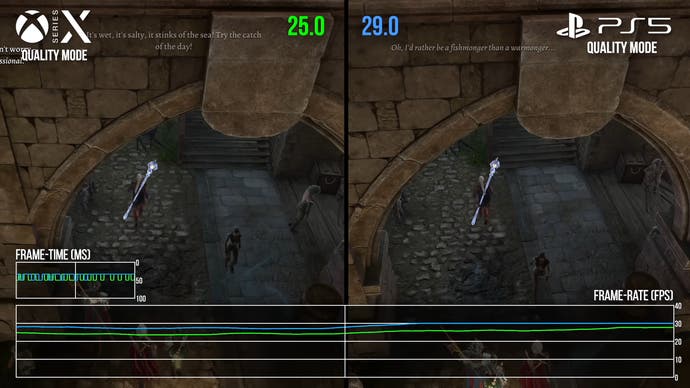Baldur’s Gate 3 is one of the most critically acclaimed games of the year, an electronic version of a great D&D campaign without the scheduling challenges that also features an incredible amount of flexibility and an engaging player-driven story. This kind of game doesn’t always translate well to consoles, but its PS5 outing from September worked quite well, absent some quibbles with the gamepad controls and occasional performance issues. Now the long-awaited Xbox version has finally arrived on Series X and Series S, so how does it hold up against the patched PS5 version – especially on the entry-level Xbox Series S?
Before we delve into the Xbox Series machines then, I wanted to provide a quick refresher on the PS5 version. It’s been three months since we last looked at the PS5 code, and the game has seen a dozen updates since then. Initial impressions suggest limited visual changes, with slightly more diffuse and realistic shadows that could be the result of a change to shadow filtering, plus higher-res blood decals and water with more prominent specular effects.
Image clarity looks similar between the two patches, with a 1440p-like resolve and slight FSR 2 artefacts evident, but the actual resolutions are different in the latest patch as dynamic resolution scaling has been added. Performance mode now comes in at 1080p internally, up from a fixed 960p at launch, while quality mode remains at 1440p but drops below this are now possible in extremely demanding scenes.
Finally, frame-rates on PS5 have been much improved, especially in the CPU-heavy third act of the game, mirroring the advances we’ve seen on the PC version. Previously we saw frame-rates in the low twenties or upper teens in town areas with lots of NPCs, but now frame-rates are in the low 30s in performance mode (with some screen-tearing) and a nearly locked 30fps in quality mode. Considering this comes without any obvious settings downgrades, this is a clear result.
This leads onto our coverage of the Xbox versions. We know that PS5 and Series X tend to be quite evenly matched in multiplatform software, so how do they stack up in Baldur’s Gate 3?
Visually, there’s not a lot to separate them, but there are a few curious differences. The ground surface appears slightly higher on the Series X in my testing across many of the game’s environments. If you look closely at character feet, I think the ground on the Series machine is a closer match in many instances for foot placement. The actual ground geometry appears similar though across both machines though.

I also noticed a decrease in anisotropic filtering quality on Series X. The PS5 acquits itself pretty well here, while the Series X takes a noticeable hit to clarity. When the camera runs perpendicular to the scene, the difference can be quite significant, though in gameplay from isometric or overhead camera perspectives it’s a lot less noticeable. I also spotted some differences in the water, with the Xbox version retaining some of the hazy-looking water at a distance, which I think is an attempt to give the water an impression of more natural sky reflection. At close range, the water looks identical though.
Outside of those changes, in general visual settings the two consoles are a close match. That applies equally across both modes on both consoles, because the performance and quality modes have matching settings outside of resolution. The Series X’s visual changes carry over to both modes in the exact same manner.
In terms of image quality, both systems deliver a reasonably good looking image on a 4K television set, albeit a slightly soft one. On Series X I did notice a couple of curious things though, like visibly lower-resolution HUD elements. But when I went to pixel count the image, it came in at very similar figures to the PS5 build – a straight 1440p in quality mode, and 1080p in the performance mode.
Performance-wise, the quality mode targets a 30fps update and does a very good job of hitting that target. In general play it’s essentially a locked 30, including combat, cutscenes, and open-world exploration. The town of Baldur’s Gate in Act 3 still poses some issues though, just like the PS5 release, and interestingly Series X seems to struggle a fair bit more in hitting its frame-time targets here, with deeper and longer bouts of sub-30fps performance.
The performance mode again hits its 60fps frame-rate target without issue, generally speaking. In typical play, you might spot a one-off dropped frame from time to time, or a brief stutter very occasionally. We see still significantly degraded performance in town areas, sometimes hitting the upper 20s.
Baldur’s Gate 3 also lets the game tear in a small area near the top of the screen in its performance mode, to prioritise image response when the game is under load. This is less obtrusive than the tearing on PS5, which lets the game tear on both the top and bottom margins of the screen. For a slow-paced game like this I would probably prefer a perfectly v-synced presentation, but it doesn’t matter that much.

There’s also a co-op mode, which ran consistently at 30fps my testing. The resolution here comes in at 1440p, just like the quality mode. A slow-paced game like Baldur’s Gate 3 makes for a bit of an unconventional couch co-op experience, but it seems to work well if you feel so inclined.
Microsoft’s pint-sized current-gen console typically takes some substantial cutbacks in current-gen software, so what’s the score with Baldur’s Gate 3 on Series S?
There are a few points of differentiation. Shadow quality, for instance, is clearly lower resolution than on Series X. The shadowmaps have more visible breakup and resolve less fine detail than the premium machine, though they still look decent enough I’d say. Level of detail gets a bit of a simplification at a distance as well.

Outside of those tweaks, I didn’t spot any especially noticeable visual changes relative to Series X. Texture filtering, for instance, appeared quite similar, and any other obvious tweakables seemed about the same. Visual settings differences in Baldur’s Gate 3 on PC tend to be very subtle though, so I imagine the game could be dropping a broader range of settings, but in either case any downgrades aren’t visually obvious onscreen.
Resolution expectedly takes a hit on Series S, clocking in at 1080p in every shot I tested. This doesn’t appear to come with any FSR 2 treatment, as characteristic FSR 2 artefacts like the ghosting trails behind falling leaves don’t make an appearance. The final image output looks noticeably softer and more aliased on Series S, with HUD elements even exhibiting obvious stair-stepping. But I’d say the game looks fine enough, with a less obvious visual downgrade than we see in the majority of Series S titles.
The game’s singular mode on Series S targets 30fps, which feels fine by and large. In general play the frame-rate is generally locked to that target, as expected, with a consistent beat of 33ms frames. In our Act 3 stress test, the game performs almost identically to the Series X in its quality mode – holding 30fps more often than not, but struggling somewhat in the most demanding spots.

I’d love to take a crack at the game’s splitscreen co-op functionality on Series S as well, but the feature has been omitted entirely from the launch release. According to Larian, this mode presented substantial development difficulties, and the requirement to keep feature parity on the two machines – as per Microsoft’s technical requirements – was delaying development. With an exemption granted from Microsoft, the final game completely lacks splitscreen on the weaker console. The Series S’ restricted RAM allotment probably makes this kind of feature especially challenging to implement here.
Baldur’s Gate 3 on Xbox consoles comes in more or less as expected. Relative to the PS5 release, there are some slightly odd visual differences and a small performance delta in favour of PS5, but overall it’s a very similar experience to the existing console release. That means you’re getting a good-looking, very playable interpretation of Baldur’s Gate 3, albeit with a control and UI setup that feels a little clunky relative to mouse and keyboard play on a PC.

The game continues to have some configuration oddities as well. For example, the graphical modes on PS5 and Series X look nearly identical to each other, primarily separated by different frame-rate targets instead of a meaningful difference in visual features or image clarity. I think using FSR 2 to hit a higher final resolution – perhaps a full 4K – would better suit the quality modes. At the moment, there’s not much reason to go with the quality modes on either console, except perhaps in Act 3 where frame-rates in performance mode go a little haywire.
The Xbox versions also currently suffer from an issue that can make saved games disappear. I didn’t encounter this issue myself – and the problem seems to be related to the Xbox cloud save system on Microsoft’s end – but prospective players may want to hold off until there’s a definitive fix.
Overall I’d consider the Baldur’s Gate 3 Xbox Series ports to be a qualified success. There are still some issues here, but this is a perfectly playable and reasonably performant version of Larian’s acclaimed RPG.
